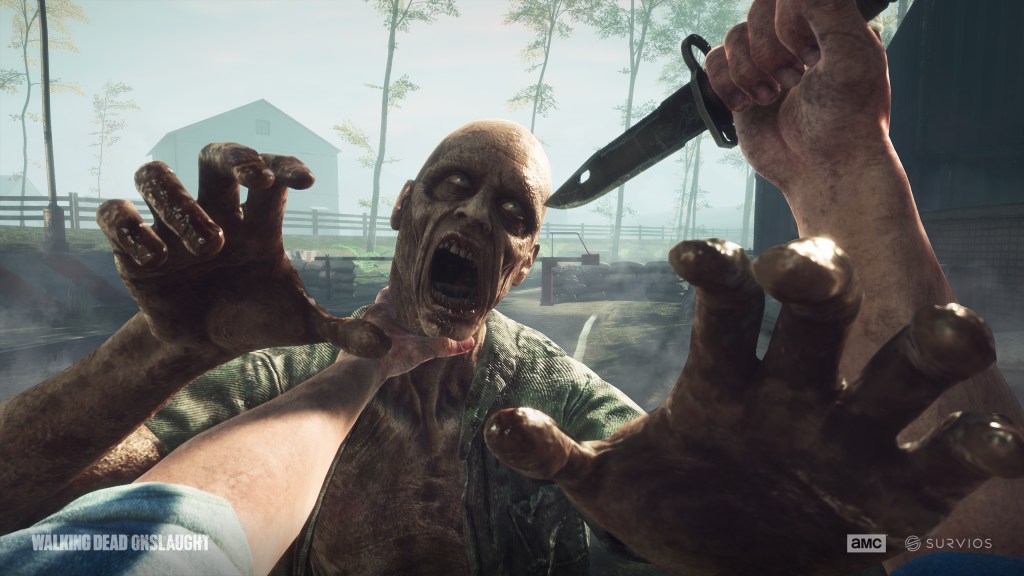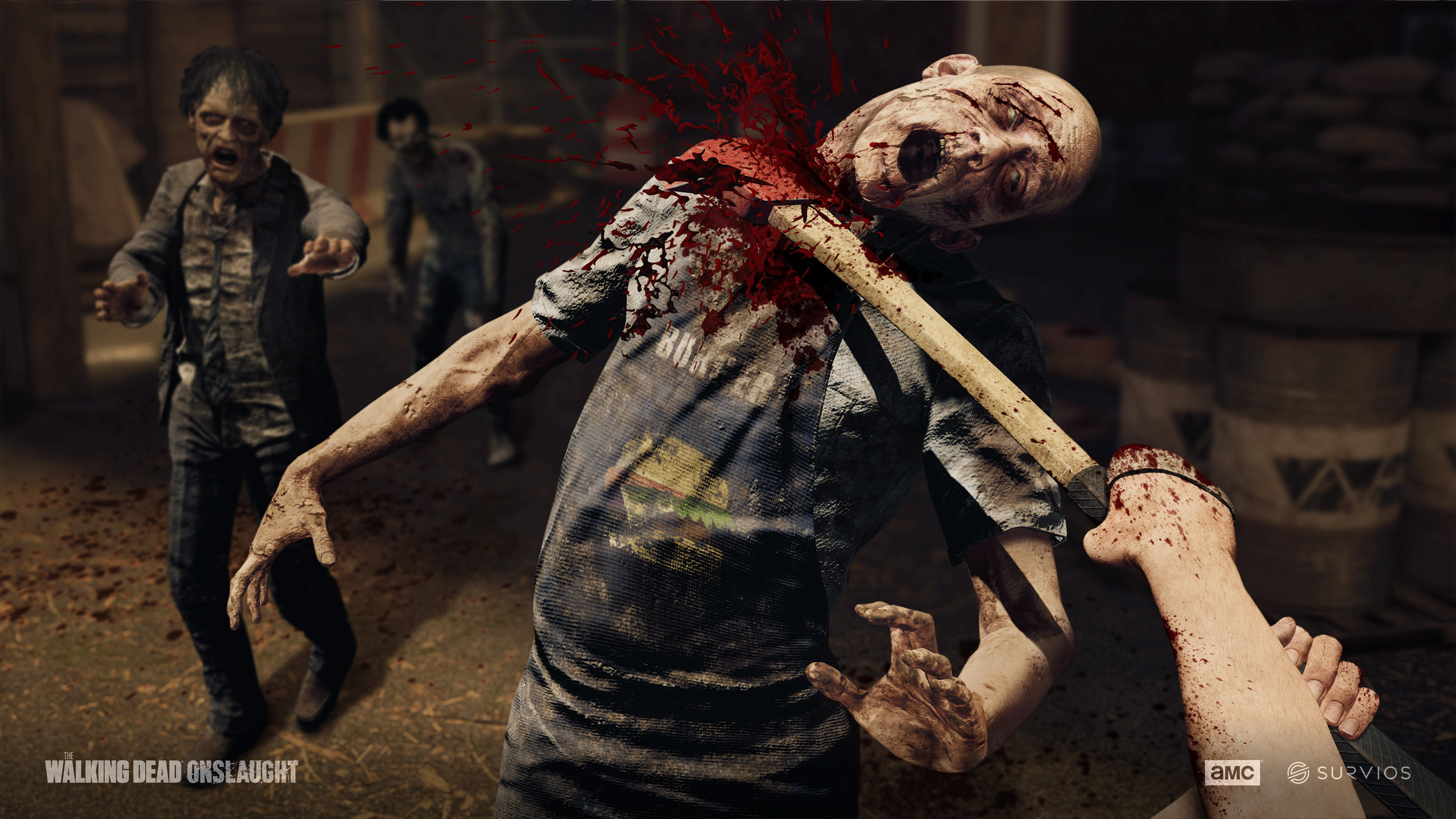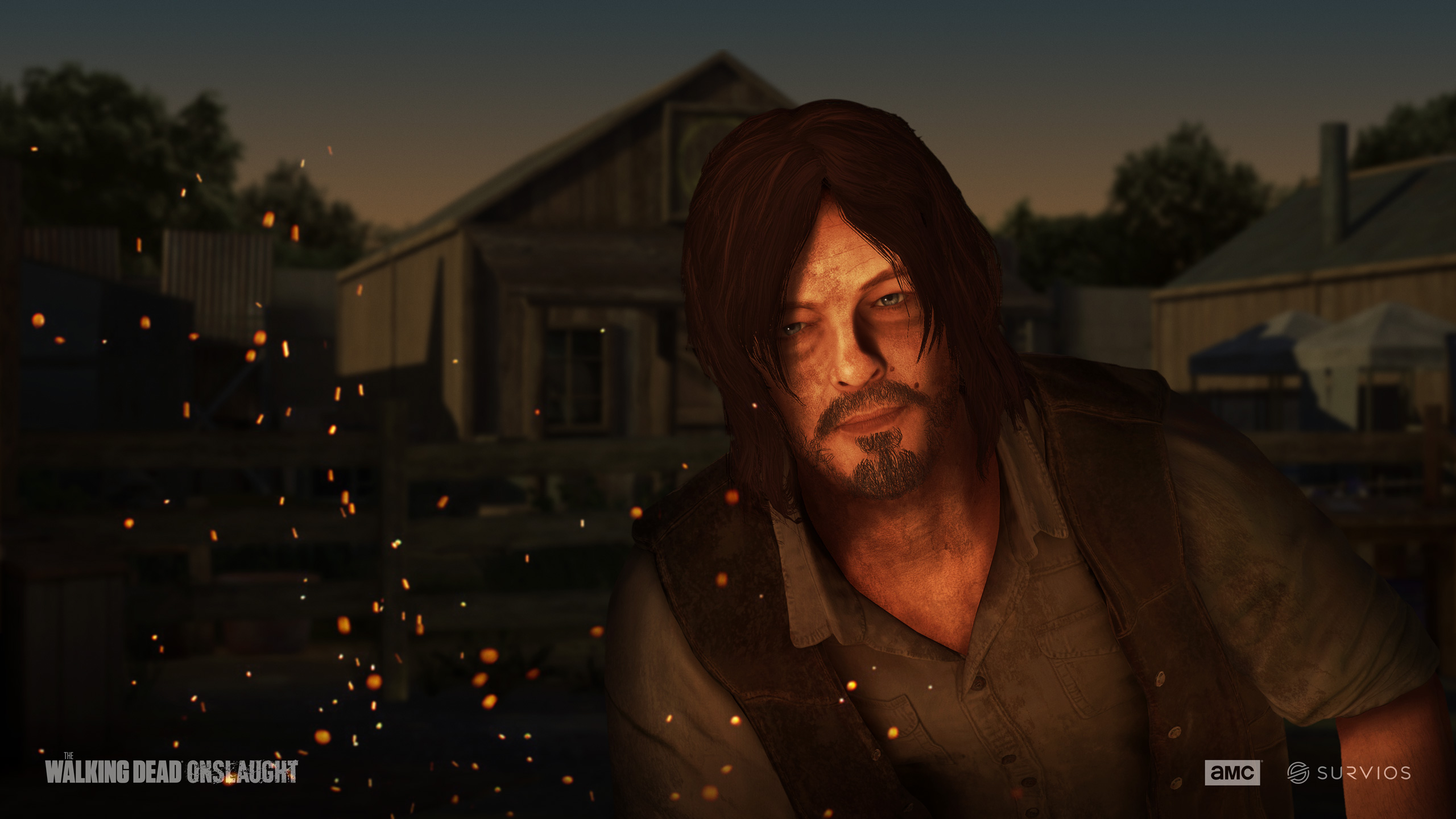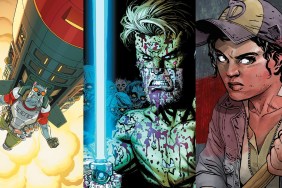It’s impossible not to compare The Walking Dead Onslaught to The Walking Dead Saints & Sinners. Both are VR games. Both are based on The Walking Dead. And both have rather similar mechanics in terms of getting up close and personal with the zombies. Onslaught differs in pulling characters, locations, and storylines directly from the AMC TV series, and also has a much more arcade-like feel to it.
The Walking Dead Onslaught is effectively two games. One one side, there’s a somewhat brief campaign, where you take on the role of Daryl Dixon in flashbacks as he and Rick Grimes talk about events that occurred. Interspersed between these story chapters is a town-building survival game, where you go on scavenging runs as Rick, Michonne, or Carol to build up the Alexandria community. Yet neither aspect is as fully fleshed out or integrated as it could be. With Saints & Sinners in recent memory, Onslaught just feels like a big step backwards as a VR title.
The levels are drab and same-y layouts of paths created by boxes and debris that feel more like a cheap haunted house than an immersive VR world. Sometimes you’ll enter a room, see a door on the other side, but have to walk through a serpentine path made of random stuff to get there. Outdoor areas are similarly blocked off in ways that scream “video game level design” and kill a lot of the immersion in the world. The snaking linear pathways don’t offer up much in the way of interesting elements, barely prompting reasons to explore. This is especially true in the story missions, which are more or less self-propelled on-rails runs through crowds of zombies. There are a few surprises and twists and turns along the way, but this is largely a point A to point B trudge to complete the levels and get to the next part of the story.
The Walking Dead Onslaught Review – The Reedus Factor
Tying into AMC’s The Walking Dead lends Onslaught some strength, at least. Norman Reedus, Melissa McBride, and Josh McDermitt reprise their roles as Daryl, Carol, and Eugene, respectively. The voice actors who play Rick and Michonne do a decent enough job as soundalikes, even if it took me longer than I’d like to admit to realize I was playing as Rick during the prologue. The story takes place following the conclusion of Season 8 leading into the first episode of Season 9, as is considered canon to the show. As such, there are numerous references and Easter eggs to other characters and events from the show, including Morgan leaving (before appearing on Fear the Walking Dead), the recent war with the Saviors, and other communities like Hilltop.
Daryl’s story is your typical zombie apocalypse themed “who is the monster, the undead or the living?” type of narrative, serviceable but not offering anything terribly intriguing. It ultimately ends up feeling like a filler episode of the series, a nice set of references, Easter eggs, and supplementary material to the main TV show for the most hardcore fans, but ultimately an unnecessary piece of a licensed property that doesn’t add much to the bigger picture. Kind of reminds me of LOST Via Domus in that way.
Scavenging missions are very gamified experiences, with a couple of variations offering some different mechanics. One has players running through a relatively straightforward area, with small side paths containing supplies (and walkers, of course). The encroaching horde, represented by a red line of fog that consumes the level, makes this a frantic timed mission to loot areas before they are behind that death wall. Another is survival, simply looting a non-linear area and surviving against walkers long enough for Eugene to come and extract you in his van. Survival was my preferred method of scavenging materials, feeling much more immersive and less arcade-like than the artificial fog wall that represented the horde. Still, neither manages to reach the same level of immersive survival scavenging that Saints & Sinners captured so well.
Part of the issue is the complete imbalance of in-game mechanics for taking out zombies. Firearms are far too weak, taking multiple headshots to even take out a single walker. I managed to get through almost everything by taking even un-upgraded melee weapons like the hammer and waggling my hand at the zombies until they died. There are upgrade paths for the game’s myriad weapons—24 in total—but the sheer variety isn’t matched within gameplay balance for those weapons. Ammo for guns is too prevalent while also being too weak to make a significant dent in the hordes. Meanwhile, melee weapons all but guarantee you can handle anything coming your way with very few drawbacks. I hate to keep returning to the Saints & Sinners comparison, but little things like noise drawing walkers to you, degrading melee weapons, and ammo scarcity lent a lot to its survival gameplay and immersion. I actually felt like I was there, surviving in the zombie apocalypse. Onslaught instead just feels like an arcadey zombie-slayer riding on the likenesses of Daryl and Rick.
The Walking Dead Onslaught Review – Gamification Over Immersion
That’s not to say The Walking Dead Onslaught is a bad game by any means. Maybe that arcadey feel is exactly what they were going for, leaning into the action rather than the tension and horror. But its overly linear and gamified nature is a step back from how far VR games have come. Perhaps it would have felt more at home a couple of years ago, really acting as a bridge between Season 8 and Season 9, rather than coming in 2020 with dated VR mechanics and an old story. PSVR also doesn’t do the game any favors, highlighting once again Sony’s desperate need to upgrade its headset. Still, I’m consistently impressed with what developers are managing to pull out of the aging and limited tech.
I also found Onslaught to give me some terrible VR sickness upon removing the headset, where I can normally handle virtual reality without breaking a sweat. The last game to give me such a dramatic and nauseating reaction was Robinson: The Journey back in 2016. I think the queasy feeling came thanks to what I perceived as framerate issues while turning, and could be due to playing on an old standard launch PS4, so your mileage may vary. There are a number of comfort options to help resolve such issues (snap turning, teleport movement, etc.), but where I’ve handled immersive free movement and smooth turning in other VR games without problems (again, Saints & Sinners), the sickness I felt after playing this one was notable.
The Walking Dead Onslaught is a serviceable enough Walking Dead VR game if it piques your interest, but its hard for me to recommend. While the ties to the AMC series are fun and interesting, Saints & Sinners is simply a better game. I traditionally don’t like comparisons in reviews, but the release dates, themes, and mechanics of these two are just too close to ignore. Fans of AMC’s The Walking Dead will probably enjoy Onslaught as a bit of supplementary material featuring characters and locations from the show, but Survios’ take on the world is just an okay VR game that doesn’t strike any notable chords for either The Walking Dead or VR in general.
The Walking Dead Onslaught review code provided by publisher. Reviewed on a standard PS4 and PSVR. For more information on scoring, please read our Review Policy.
-
Ties into AMC's The Walking Dead
-
Daryl, Carol, and Eugene actors voice their characters
-
Killing zombies is almost always a good time
-
Imbalanced weapons make combat rather dull
-
Some odd "gamey" choices that kill the tension
-
Boring linear environments
-
Potential for VR unease due to performance issues












